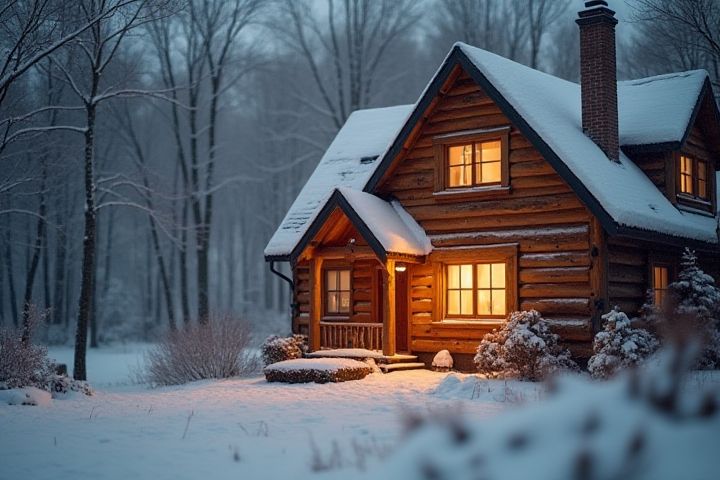
To efficiently heat your house in winter, consider investing in a high-quality programmable thermostat that allows you to control the temperature automatically based on your schedule. Insulating your home can significantly reduce heat loss; focusing on areas like windows, doors, and attics can create a more energy-efficient environment. Utilizing energy-efficient heating systems, such as a heat pump or a condensing boiler, can lower your energy bills while providing consistent warmth. Incorporating space heaters in frequently used rooms can offer targeted heating and reduce the need to heat unoccupied spaces. Regular maintenance of your heating system ensures optimal performance, prolonging its lifespan and enhancing its efficiency throughout the cold months.
Best Way To Heat A House In Winter
Insulation effectiveness
Effective insulation plays a crucial role in maintaining a comfortable home during winter months, with a potential energy savings of up to 30%. Prioritize materials with high R-values, such as rigid foam boards or spray foam, as they significantly reduce heat loss through walls and ceilings. Properly sealed windows and doors can further enhance insulation performance, reducing drafts by approximately 20%. Investing in quality insulation not only improves your home's energy efficiency but also lowers heating bills while creating a cozy environment.
High-efficiency furnace
A high-efficiency furnace operates at over 90% efficiency, converting most of its fuel into usable heat, which significantly reduces energy costs during winter. When selecting a model, consider features like variable-speed blowers and advanced thermostats that optimize airflow and maintain consistent temperatures. Regular maintenance, such as annual inspections and filter changes, ensures optimal performance and longevity. By investing in a high-efficiency furnace, you not only enhance your home's comfort but also contribute to lower carbon emissions, making it an environmentally friendly choice.
Heat pumps
Heat pumps are an efficient and eco-friendly option for heating your home during winter, with energy efficiency ratings often exceeding 300%. These systems work by transferring heat from the outside air or ground into your home, even in temperatures as low as -15degF (-26degC). By using electricity to move heat rather than generating it, heat pumps can substantially reduce your heating bills, saving homeowners up to 50% compared to traditional gas or electric heating systems. Investing in a high-quality heat pump can lead to long-term energy savings and a smaller carbon footprint, making it a wise choice for sustainable home heating.
Radiant floor heating
Radiant floor heating efficiently warms your home by distributing heat evenly across the floor surface. This system operates using electric heating cables or hydronic tubes filled with warm water, providing a cozy environment with minimal energy loss. Studies show that radiant floor heating can reduce energy bills by up to 30% compared to traditional heating methods. With benefits like improved air quality and silent operation, it's an optimal choice for maintaining comfort during cold winter months.
Smart thermostats
Smart thermostats are a highly effective way to optimize your home's heating during winter. These devices learn your heating preferences and adjust temperatures accordingly, ensuring maximum comfort while minimizing energy consumption. By utilizing Wi-Fi connectivity, you can control your thermostat remotely via smartphone apps, allowing you to adjust settings even when you're not at home. Many models also provide energy usage reports, helping you understand your heating habits and make informed adjustments to enhance efficiency.
Energy-efficient windows
Energy-efficient windows can significantly reduce heating costs during winter by minimizing heat loss. By utilizing double or triple glazing, these windows provide a barrier that retains indoor warmth while blocking cold drafts. Investing in high-performance windows with low-E coatings can enhance insulation, reflecting heat back into your home and reducing reliance on heating systems. Upgrading to energy-efficient windows can save homeowners up to 30% on their energy bills, making it a smart investment for improved comfort and sustainability.
Space heaters
Space heaters are an efficient way to heat individual rooms during winter, providing quick warmth where you need it most. Electric space heaters, such as ceramic or oil-filled models, are popular for their portability and safety features, making them suitable for bedrooms or living areas. When using a space heater, ensure proper ventilation and safety measures are in place to prevent fire hazards. To maximize efficiency, consider using a programmable thermostat or timer, allowing you to maintain comfortable temperatures without wasting energy in unoccupied spaces.
Solar heating
Solar heating systems harness the sun's energy to efficiently warm your home during winter months. These systems typically include solar collectors, which capture sunlight and convert it into heat, and a storage component, like a hot water tank, to maintain warmth even when the sun isn't shining. By integrating solar heating with your existing HVAC system, you can significantly reduce energy bills and reliance on fossil fuels. Implementing solar heating contributes to a sustainable environment and enhances your home's energy efficiency.
Pellet stoves
Pellet stoves are an efficient and environmentally friendly heating option for your home during winter. They use compressed wood pellets as fuel, which are both cost-effective and produce less carbon emissions compared to traditional heating methods. With advanced features like programmable thermostats and automatic feeding systems, pellet stoves offer convenience and consistent warmth. Regular maintenance, such as cleaning the ash and checking the exhaust, ensures optimal performance and longevity for your heating system.
Weather stripping techniques
Weather stripping is an essential technique for maintaining an energy-efficient home during winter, helping to reduce heating costs by up to 15%. It involves sealing gaps around doors and windows, preventing cold air infiltration and retaining warm indoor air. Common materials for weather stripping include foam tape, felt, and vinyl, each offering varying levels of insulation and ease of installation. Regularly inspecting and replacing worn weather stripping ensures optimal performance, keeping your home comfortable and energy-efficient throughout the chilly months.
